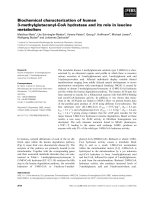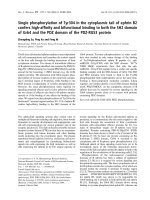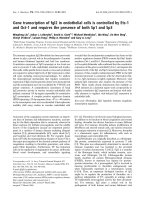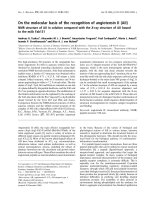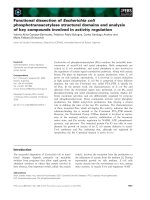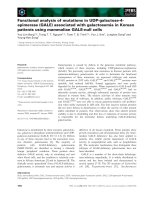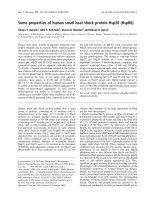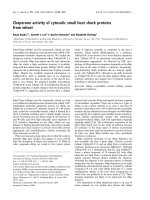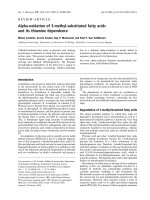Báo cáo khoa học: "The choice of catecholamines in septic shock: more and more good arguments to strengthen the known position, but don’t lose the faith" pptx
Bạn đang xem bản rút gọn của tài liệu. Xem và tải ngay bản đầy đủ của tài liệu tại đây (32.07 KB, 2 trang )
Page 1 of 2
(page number not for citation purposes)
Available online />Abstract
The choice of catecholamines for hemodynamic stabilisation in
septic shock patients has been an ongoing debate for several
years. Several studies have investigated the regional effects in
septic patients. Because of an often very small sample size,
because of inconsistent results and because of methodical
problems in the monitoring techniques used in these studies,
however, it is not possible to provide clear recommendations
concerning the use of catecholamines in sepsis. Prospective and
adequate-sized studies are necessary because outcome data are
completely lacking.
The choice of catecholamines for hemodynamic stabilisation
in septic shock patients has been an ongoing debate for
several years. The well-performed investigation from Seguin
and colleagues [1] adds further knowledge to this debate by
demonstrating that a combination of norepinephrine and
dopexamine might be superior to the use of epinephrine
alone. The superiority of the combination of norepinephrine
with dopexamine can be explained by the fact that
norepinephrine seems to be a better vasopressor than
epinephrine. The fact that epinephrine is not the vasopressor
of first choice due to its harmful effects on intestinal perfusion
might be well accepted since several studies have
demonstrated such adverse effects [2-4] and no study has
demonstrated beneficial effects on regional perfusion.
Perhaps only the addition of dopexamine caused the
beneficial effects of this catecholamine combination, but this
cannot be answered by the chosen study design. A clear
assessment of the value of dopexamine is not possible. In
some studies dopexamine either given alone or in
combination with another catecholamine improves intestinal
perfusion [5,6], but in other studies dopexamine does not
affect or even deteriorates intestinal perfusion [7,8].
Translating these results into clinical practice, we have to ask
whether we should stop the use of epinephrine and start to
increase the blood pressure in our patients primarily with the
combination of norepinephrine and dopexamine? One
answer could be ‘yes and no’ — yes, do not use epinephrine,
because I am an ‘epinephrine is bad’ believer; and no, do not
use dopexamine, because I am a ‘dopexamine doesn’t work’
believer. Of course another answer also seems to be
reasonable, but unfortunately not because of deeper insight
into the effects and side effects of catecholamines rather
than just a different conviction.
Why do we have, on one hand, more and more studies
dealing with the global and regional effects of catechol-
amines, but on the other hand we have no clear or even
controversial recommendations concerning the use of vaso-
active drugs? There are only a few basic rules concerning the
use of catecholamines in the stabilisation of septic patients
that are widely accepted without further need for discussion.
We know that parameters of the global hemodynamic in a
normal range do not guarantee adequate regional perfusion
[9]. We have learned that the effects of catecholamines can
be different in septic and nonseptic conditions [10].
Moreover, there is evidence that these effects can even be
different in severe sepsis and septic shock [11]. Furthermore,
it is well accepted that hemodynamic stabilisation has to be
achieved as soon as possible [12].
For all other aspects of hemodynamic stabilisation, there is
wide room for discussion but no clear evidence. What are the
problems?
We do not know whether the use of a specific catecholamine
can affect patient outcome. Adequate-sized, prospective,
randomised studies are missing — and because the
Commentary
The choice of catecholamines in septic shock: more and more
good arguments to strengthen the known position, but don’t lose
the faith!
Andreas Meier-Hellmann
Department of Anesthesiology, Intensive Care Medicine and Pain Management, HELIOS Klinikum Erfurt GmbH, Erfurt, Germany
Corresponding author: Andreas Meier-Hellmann,
Published: 8 March 2006 Critical Care 2006, 10:127 (doi:10.1186/cc4859)
This article is online at />© 2006 BioMed Central Ltd
See related research by Seguin et al. in issue 10.1 [ />Page 2 of 2
(page number not for citation purposes)
Critical Care Vol 10 No 2 Meier-Hellmann
catecholamines are low-budget drugs, industrial sponsoring
of such studies seems unrealistic.
The techniques used to assess the regional effects of
catecholamines in patients have several pitfalls [13]. What is
the clinical relevance of an increase in blood flow in a hepatic
vein? What is the relevance of a changed laser Doppler
signal from the gastric mucosa, a technique used in the
recent study from Seguin and colleagues, especially in view
of evidence that mucosal perfusion in different regions of the
gut does not always occur in parallel [14]?
As already mentioned, we are aware of different effects of
dopamine in severe sepsis and in septic shock. We cannot
exclude the fact that there are also differences in individual
patients, depending for example on more or less pronounced
cardiomyopathy or on differences in volume loading. Such
effects could explain the several studies investigating the
effects of catecholamines using the same techniques but
producing controversial results [6,7].
There is no doubt that well-performed studies such as that by
Seguin and colleagues enable us to gain deeper insight into
the regional effects of catecholamines. Nevertheless, for the
safe and beneficial use of catecholamines in the stabilisation
of septic patients we need hard data concerning the effects
of patient outcome. In the light of this, it is good to know that
there is an increasing number of study groups aiming to find
answers on many important questions in intensive care
medicine. Perhaps one day we will lose our faith and will use
catecholamines based on hard data.
Competing interests
The author declares that they have no competing interests.
References
1. Seguin P, Laviolle B, Guinet P, Morel I, Malledant Y, Bellissant E:
Dopexamine and norepinephrine vs epinephrine on gastric
perfusion in setic shock patients: a randomized study. Crit
Care 2006, 10:R32.
2. Meier-Hellmann A, Reinhart K, Bredle DL, Specht M, Spies CD,
Hannemann L: Epinephrine impairs splanchnic perfusion in
septic shock. Crit Care Med 1997, 25:399-404.
3. Day NP, Phu NH, Mai NT, Bethell DB, Chau TT, Loc PP, Chuong
LV, Sinh DX, Solomon T, Haywood G, et al.: Effects of dopamine
and epinephrine infusions on renal hemodynamics in severe
malaria and severe sepsis. Crit Care Med 2000, 28:1353-
1362.
4. Levy B, Bollaert PE, Charpentier C, Nace L, Audibert G, Bauer P,
Nabet P, Larcan A: Comparison of norepinephrine and dobuta-
mine to epinephrine for hemodynamics, lactate metabolism,
and gastric tonometric variables in septic shock: a prospec-
tive, randomized study. Intensive Care Med 1997, 23:282-287.
5. Maynard ND, Bihari DJ, Dalton RN, Smithies MN, Mason RC:
Increasing splanchnic blood flow in the critically III. Chest
1995, 108:1648-1654.
6. Smithies M, Yee TH, Jackson L, Beale R, Bihari D: Protecting the
gut and the liver in the critically ill: effects of dopexamine. Crit
Care Med 1994, 22:789-795.
7. Meier-Hellmann A, Bredle DL, Specht M, Hannemann L, Reinhart
K: Dopexamine increases splanchnic blood flow but
decreases gastric mucosal pH in severe septic patients
treated with dobutamine. Crit Care Med 1999, 27:2166-2171.
8. Kiefer P, Tugtekin I, Wiedeck H, Bracht H, Geldner G, Georgieff
M, Radermacher P: Effect of a dopexamine-induced increase
in cardiac index on splanchnic hemodynamics in septic shock.
Am J Respir Crit Care Med 2000, 161:775-779.
9. Ruokonen E, Takala J, Kari A, Saxen H, Mertsola J, Hansen EJ:
Regional blood flow and oxygen transport in septic shock. Crit
Care Med 1993, 21:1296-1303.
10. Bersten AD, Hersch M, Cheung H, Rutledge FS, Sibbald WJ: The
effect of various sympathomimetics on the regional circula-
tions in hyperdynamic sepsis. Surgery 1992, 112:549-561.
11. Meier-Hellmann A, Bredle DL, Specht M, Spies C, Hannemann L,
Reinhart K: The effects of low dose dopamine on splanchnic
blood flow and oxygen uptake in patients with septic shock.
Intensive Care Med 1997, 23:31-37.
12. Rivers E, Nguyen B, Havstad S, Ressler J, Muzzin A, Knoblich B,
Peterson E, Tomlanovich M: Early goal-directed therapy in the
treatment of severe sepsis and septic shock. N Engl J Med
2001, 345:1368-1377.
13. Brinkmann A, Calzia E, Trager K, Radermacher P: Monitoring the
hepato-splanchnic region in the critically ill patient — mea-
surement techniques and clinical relevance. Intensive Care
Med 1998, 24:542-556.
14. Lang CH, Bagby GJ, Ferguson JL, Spitzer JJ: Cardiac output and
redistrubution of organ blood flow in hypermetabolic sepsis.
Am J Physiol 1984, 246:R331-R337.
